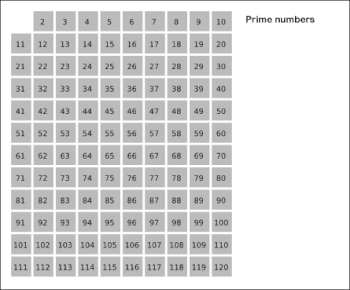埃拉托斯特尼筛法
埃拉托斯特尼筛法(古希臘語:κόσκινον Ἐρατοσθένους,英語:sieve of Eratosthenes),簡稱埃氏筛,是一种用來生成質數的筛法,得名於古希臘數學家埃拉托斯特尼。其基本步骤是從最小的質數2開始,將该質數的所有倍數標記成合數,而下一个尚未被标记的最小自然数3即是下一个質數。如此重复这一过程,将各个质数的倍数标记为合数并找出下一个质数,最终便可找出一定範圍內所有質數。
埃拉托斯特尼筛法可能在埃拉托斯特尼的时代之前就已经为人所知[1]:14,并记载于另一位古希腊数学家尼科马库斯的《算术概论》中,尽管该著作中的这一筛法是从3开始,从奇数中依次筛去奇数的倍数,而非从自然数中筛去质数的倍数[2]:242-243。
使用埃拉托斯特尼筛法找出120以内的所有質數。由于112=121>120,当11成为最小的未标记整数时,尚未标记的所有数皆可确认为質數。请注意到在标记时直接从每个质数的平方开始。
运用与示例 编辑
埃拉托斯特尼筛法通过不断地标记当前质数的所有倍数为合数,从而取得最小的未标记整数为下一个質數。不过,在实际使用此筛法寻找一个范围内的質數时,不需要检查范围内所有整数,也不需要对每个質數都标记其所有的倍数。
- 寻找
以内的質數时,若找到了一个大于
的质数,则剩余的所有尚未标记的数也都是質數。
- 标记某一質數
的倍数时,不需要每次皆从
开始,而可直接从
开始标记。
- 证明:所有较
更小的
的倍数必然拥有一个更小的质数为其因数,故在标记之前的质数的倍数时它们已经被标记过了[5]。
- 证明:所有较
若要找出25以内的所有质数,使用如上述改进过的埃拉托斯特尼筛法的具体过程如下:
- 列出2以後所有數:
- 2 3 4 5 6 7 8 9 10 11 12 13 14 15 16 17 18 19 20 21 22 23 24 25
- 记录質数2,由22=4开始划去2的倍数:
- 2 3
45678910111213141516171819202122232425
- 2 3
- 记录下一質数3,由32=9开始划去3的倍数:
- 2 3
45678910111213141516171819202122232425
- 2 3
- 记录下一質数5,由52=25开始划去5的倍数:
- 2 3
45678910111213141516171819202122232425
- 2 3
- 下一質数为7,而72=49>25,故剩余所有未标记的数皆为質数:
- 2 3
45678910111213141516171819202122232425
- 2 3
由此得到25內的質数为2,3,5,7,11,13,17,19,23。
以上的算法可用以下伪代码表示:
输入:整数n > 1 设A为布尔值矩阵,下标是2至n的整数,初始时全部设成true。 for i = 2, 3, 4, ..., 不超过 : if A[i]为true: for j = i2, i2+i, i2+2i, i2+3i, ..., 不超过n: A[j] := false 输出:使A[i]为true的所有i。
: if A[i]为true: for j = i2, i2+i, i2+2i, i2+3i, ..., 不超过n: A[j] := false 输出:使A[i]为true的所有i。埃拉托斯特尼筛法的时间复杂度为

程式码 编辑
Python 3.6-3.10 编辑
def eratosthenes(n): is_prime = [True] * (n + 1) for i in range(2, int(n ** 0.5) + 1): if is_prime[i]: for j in range(i * i, n + 1, i): is_prime[j] = False return [x for x in range(2, n + 1) if is_prime[x]]print(eratosthenes(120))C語言 编辑
int prime[100005];bool is_prime[1000005];int eratosthenes(int n) { int p = 0; for (int i = 0; i <= n; i++) { is_prime[i] = true; } is_prime[0] = is_prime[1] = 0; for (int i = 2; i <= n; i++) { if (is_prime[i]) { prime[p++] = i; if (1ll * i * i <= n) { for (int j = i * i; j <= n; j += i) { is_prime[j] = 0; } } } } return p;}C語言新版
#include <stdio.h>#include <stdlib.h>/* N: positive integer verbose: 1 -- print all prime numbers < N, 0 -- no print return total number of prime numbers < N. return -1 when there is not enough memory.*/int eratosthenesSieve(unsigned long long int N, int verbose) { // prime numbers are positive, better to use largest unsiged integer unsigned long long int i, j, total; // total: number of prime numbers < N _Bool *a = malloc(sizeof(_Bool) * N); if (a == NULL) { printf("No enough memory.\n"); return -1; } /* a[i] equals 1: i is prime number. a[i] equals 0: i is not prime number. From beginning, set i as prime number. Later filter out non-prime numbers */ for (i = 2; i < N; i++) { a[i] = 1; } // mark multiples(<N) of i as non-prime numbers for (i = 2; i < N; i++) { if (a[i]) { // a[i] is prime number at this point for (j = i; j < (N / i) + 1; j++) {/* mark all multiple of 2 * 2, 2 * 3, as non-prime numbers; do the same for 3,4,5,... 2*3 is filter out when i is 2 so when i is 3, we only start at 3 * 3*/a[i * j] = 0; } } } // count total. print prime numbers < N if needed. total = 0; for (i = 2; i < N; i++) { if (a[i]) { // i is prime number if (verbose) {printf("%llu\n", i); } total += 1; } } return total;}int main() { unsigned long long int a1 = 0, a2 = 0, N = 10000000; a1 = eratosthenesSieve(N, 1); // print the prime numbers printf("Total of prime numbers less than %llu is : %llu\n", N, a1); a2 = eratosthenesSieve(N, 0); // not print the prime numbers printf("Total of prime numbers less than %llu is : %llu\n", N, a2); return 0;}C++ 编辑
#include <vector>auto eratosthenes(int upperbound) { std::vector<bool> flag(upperbound + 1, true); flag[0] = flag[1] = false; //exclude 0 and 1 for (int i = 2; i * i <= upperbound; ++i) { if (flag[i]) { for (int j = i * i; j <= upperbound; j += i) flag[j] = false; } } return flag;}R 编辑
eratosthenes <- function(n) { if (n == 1) return(NULL) if (n == 2 | n == 3) return(2:n) numbers <- 2:n primes <- rep(TRUE, n-1) for (i in 2:floor(sqrt(n))) { if (primes[i-1]) { for (j in seq(i * i, n, i)) primes[j-1] <- FALSE } } return(numbers[primes])}JavaScript 编辑
const countPrimes = function (n) { const isPrime = new Array(n).fill(true); for (let i = 2; i <= Math.sqrt(n); i++) { if (isPrime[i]) { for (let j = i * i; j <= n; j += i) { isPrime[j] = false; } } } let count = 0; for (let i = 2; i < n; i++) { if (isPrime[i]) { count++; } } return count;};参见 编辑
参考文献 编辑
- ^ 1.0 1.1 Stefan Hougardy; Jens Vygen. Algorithmic Mathematics. Cham: Springer International Publishing Switzerland. 2016. ISBN 978-3-319-39558-6.
- ^ Jean-Luc Chabert. A History of Algorithms: From the Pebble to the Microchip. Berlin, Heidelberg: Springer-Verlag. 1999. ISBN 978-3-642-18192-4.
- ^ George M. Phillips. Mathematics Is Not a Spectator Sport. New York: Springer-Verlag. 2005. ISBN 978-0-387-28697-6.
- ^ G. H. Hardy; E. M. Wright. An Introduction to the Theory of Numbers (Fourth Edition). Oxford: Clarendon Press. 1960. ISBN 978-0-19-853310-8.
- ^ 5.0 5.1 Melissa E. O'Neill. The Genuine Sieve of Eratosthenes (PDF). Journal of Functional Programming. 2009, 19 (1): 95–106. doi:10.1017/S0956796808007004.

